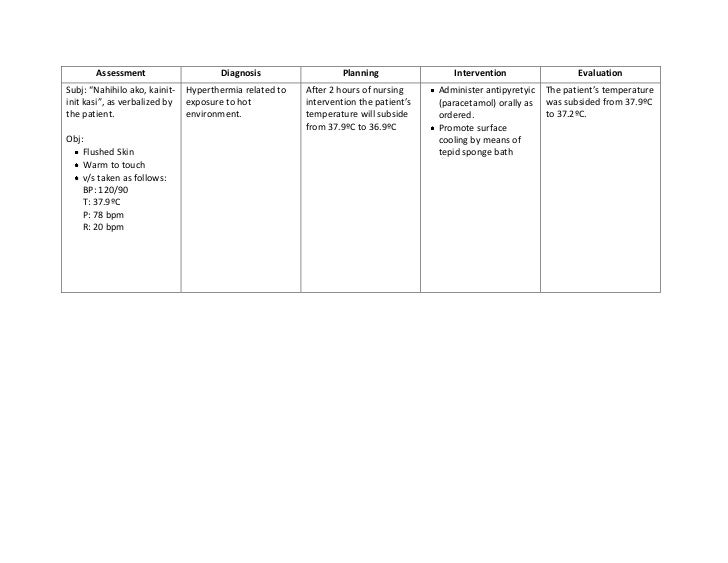SOLUTION Nursing care plan hyperthermia related to inflammatory process ncp Studypool

Hyperthermia NCP Fever Hyperthermia
6 Sepsis Nursing Care Plans. Updated on October 13, 2023. By Paul Martin, BSN, R.N. Make use of this in-depth nursing care plan and management guide to aid in the care of patients with sepsis. Expand your knowledge base of nursing assessments, interventions, goal setting, and nursing diagnoses, to meet the distinct needs of patients with sepsis.

SOLUTION Nursing care plan hyperthermia related to inflammatory process ncp Studypool
Nursing diagnosis and care planning are essential in managing hyperthermia. Nurses play a crucial role in assessing and monitoring the patient's body temperature, identifying the underlying cause of the fever, and implementing appropriate interventions to manage the symptoms.

NCP hyperthermia
Nursing care plan hyperthermia/fever. Hyperthermia is a condition of increased body temperature which can lead to many other problems. The body's normal core temperature is around 37 °C (98.6 °F). Any increase or decrease from this number can cause issues such as hyperthermia and hypothermia, respectively.

hyperthermia ncp Hyperthermia Perspiration
Hyperthermia (Fever) Nursing Care Plan and Management Updated on October 13, 2023 By Matt Vera BSN, R.N. This nursing care plan and management guide can assist in providing care for patients with hyperthermia or fever.

Definition of the Case + Hyperthermia NCP Assessment Diagnosis Planning Intervention Rationale
Fever (Hyperthermia) Care Plan, Drugs, Diagnosis, Intervention By RNspeak - December 28, 2017 Modified date: June 19, 2021 Hyperthermia or commonly known as fever is present when the body temperature is higher than 37ᴼC which can be measured orally, but 37.7ᴼC if measured per rectum.

NCP (hyperthermia) Hyperthermia Medical Specialties
Hyperthermia Care Plan . Fever is the most common infusion reaction symptom and can be caused by hypersensitivity to donor blood cells or cytokines accumulating in stored blood products. Nursing Diagnosis: Hyperthermia. Related to. Adverse reaction from a blood transfusion; As evidenced by:

NCP for potfolio nursing care plan on hyperthermia, acute pain, activity intolerance
Defining Characteristics When nursing diagnosis hyperthermia is made, there are various defining characteristics that should be taken into consideration. These include subjective parameters such as headache, dizziness, nausea, increased heart rate, respiratory rate and perspiration.

SOLUTION Hyperthermia related to inflammatory response ncp Studypool
#1 Sample Nursing Care Plan for Fever (Hyperthermia) - Hyperthermia Hyperthermia Nursing Assessment Subjective Data: The patient complains of chills Objective Data: The patient's temperature is 40 C The patient's heart rate is elevated He is diaphoretic, flushed, and shivering Hyperthermia Nursing Diagnosis

Ncp Hyperthermia Docx Nursing Care Plan Nursing Diagnosis The Best Porn Website
Nursing Care Plan for Hyperthermia The normal human body temperature in health can be as high as 37.7 °C (99.9 °F) in the late afternoon. Hyperthermia is defined as a temperature greater than 37.5-38.3 °C (100-101 °F), depending on the reference used, that occurs without a change in the body's temperature set point.

Nursing Care Plan Infection) Hyperthermia Diseases And Disorders
This nursing care plan and diagnosis with nursing interventions is for the following conditions: Hyperthermia, Fever, High Temperature What are nursing care plans? How do you develop a nursing care plan? What nursing care plan book do you recommend helping you develop a nursing care plan?

nursing care plan Hypoxia (Medical) Hyperthermia
Hyperthermia Nursing Diagnosis & Care Plans Written by Maegan Wagner, BSN, RN, CCM Reviewed by Alex Lukey, MSN, RN Hyperthermia is a body temperature above 104°F (40°C). Hyperthermia occurs when the body's thermoregulatory system fails, after being exposed to too much heat or when the body generates more heat than it can release.

Hyperthermia Nursing Care Plan For Hyperthermia
Types of Fever Based on Body Temperature. 1. Low-Grade Fever: A low-grade fever is a mild fever with a body temperature of 100.4°F (38°C) to 101°F (38.3°C). It is frequently connected with minor diseases such as the common cold or flu and normally cures on its own within a few days. 2.

Hyperthermia Nursing Care Plan For Hyperthermia
(a) Temperature >40C (104F). (b) Neurologic manifestations (e.g. altered mental status, ataxia, seizure). (c) Caused primarily by exertion or exposure. exertional heat stroke Caused by exertion in hot weather (e.g. marathoners, military recruits).

SOLUTION UST BSN Nursing care plan ncp hyperthermia related to inflammatory response Studypool
The care plan for hyperthermia involves a combination of medical and nursing interventions to lower the body temperature and prevent further complications. Nursing Interventions for Hyperthermia The following are some of the nursing interventions for hyperthermia:

NCP Hyperthermia Hyperthermia Medicine
1. Assess for signs away hyperthermia. Flushed face with skin that is hot to touch, weakness, fatigue, pain, and abnormal vital signs are can displays of hyperthermia. 2. Judging for primary conditions.

Ncp on hyperthermia Nursing Care Plan (NCP) Hyperthermia Assessment Diagnosis Inference
Health Library / Diseases & Conditions / Hyperthermia Hyperthermia Hyperthermia is an abnormally high body temperature. Also called heat illnesses, there are several forms of hyperthermia. Heat cramps are fairly mild, whereas heat exhaustion is more severe. Heatstroke is the most serious form of hyperthermia and can be life-threatening.